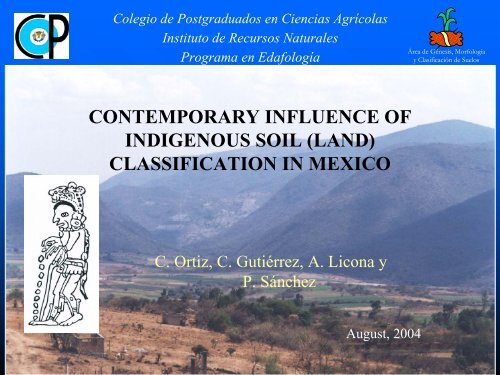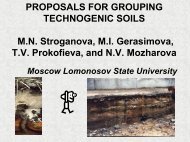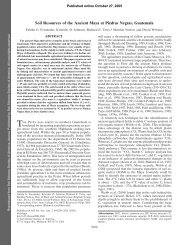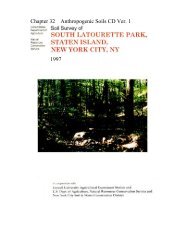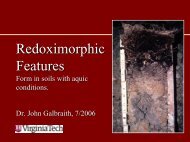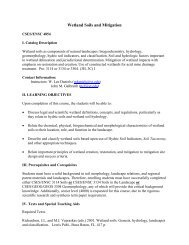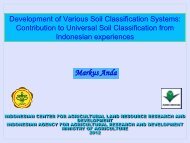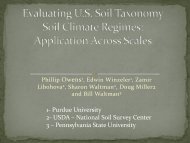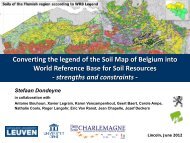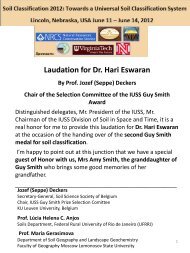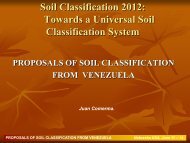Ortiz et al-Contemporary Influence of Indigenous Soil.pdf
Ortiz et al-Contemporary Influence of Indigenous Soil.pdf
Ortiz et al-Contemporary Influence of Indigenous Soil.pdf
You also want an ePaper? Increase the reach of your titles
YUMPU automatically turns print PDFs into web optimized ePapers that Google loves.
Colegio de Postgraduados en Ciencias Agrícolas<br />
Instituto de Recursos Natur<strong>al</strong>es<br />
Programa en Edafología<br />
CONTEMPORARY INFLUENCE OF<br />
INDIGENOUS SOIL (LAND)<br />
CLASSIFICATION IN MEXICO<br />
C. <strong>Ortiz</strong>, C. Gutiérrez, A. Licona y<br />
P. Sánchez<br />
August, 2004<br />
Área de Génesis, Morfología<br />
y Clasificación de Suelos
Ethnopedology<br />
-In Mexico the<br />
Ethnopedologic<strong>al</strong><br />
research has been<br />
carried out for<br />
more than 20 years;<br />
-From the first works<br />
we noticed:<br />
A confrontation
First Problems<br />
After some studies it was<br />
found:<br />
1) Our lack <strong>of</strong> preparation<br />
for communicating with<br />
farmers;<br />
soil – land<br />
2) Our necessity <strong>of</strong> a<br />
change <strong>of</strong> ment<strong>al</strong>ity<br />
Equ<strong>al</strong>ity conditions
Loc<strong>al</strong> Land<br />
Knowledge<br />
•Farmers perceive and use<br />
lands as areas;<br />
•Their nomenclature is simple<br />
(Sandy land or Black land)<br />
•Land characterization is<br />
taking into account many<br />
attributes
Loc<strong>al</strong> Land Taxonomy<br />
In the first study<br />
An erroneous conclusion<br />
Loc<strong>al</strong> land – two-dimension<strong>al</strong><br />
<strong>Soil</strong> – three-dimension<strong>al</strong>.<br />
The characterization <strong>of</strong> topsoil:<br />
+ An<strong>al</strong>ytic<strong>al</strong> m<strong>et</strong>hods <strong>of</strong> <strong>Soil</strong><br />
Science<br />
+ Multivariate statistic<strong>al</strong> m<strong>et</strong>hods.<br />
Land Sand ECe<br />
Class % dS/m<br />
ARENA (Sandy) 62 1.2<br />
BARRO 19 0.9<br />
BLANCA 44 0.9<br />
LAMA 39 0.8<br />
CACAHUATUDA 21 2.3<br />
SALINA (S<strong>al</strong>ine) 29 67.7<br />
BA<br />
CA<br />
BL<br />
AR<br />
LA<br />
SA<br />
+------------------------+<br />
0 0.5
Nomenclature<br />
State <strong>of</strong> Yucatan<br />
MAYAN<br />
GROUP<br />
(Perez,1984)<br />
-Ak<strong>al</strong>ché<br />
-Kancab<br />
-Pus-Lum<br />
-Yaax-hom<br />
State <strong>of</strong> Hid<strong>al</strong>go State <strong>of</strong> Mexico<br />
OTOMI<br />
GROUP<br />
(Quiroz, 1983)<br />
-Pehai<br />
-T’axhai<br />
-’Bomuhai<br />
-Xidohai<br />
HUASTEC<br />
GROUP<br />
(Castro, 2001)<br />
-T<strong>et</strong>ic Tl<strong>al</strong>li<br />
-Yayac Tl<strong>al</strong>li<br />
-Atl<strong>al</strong>li<br />
-Tep<strong>et</strong>atl Tl<strong>al</strong>li<br />
MATLAZINCAN<br />
GROUP<br />
(Abasolo, 2001)<br />
-X<strong>al</strong>pa<br />
-Atl<strong>al</strong> Chichiltli<br />
-Chinampa<br />
-Tl<strong>al</strong>li Cliltli
Loc<strong>al</strong> Land Classification<br />
• The problem <strong>of</strong> dimensions have<br />
originated a low correspondence<br />
b<strong>et</strong>ween taxa<br />
• Other options:<br />
Berlin <strong>et</strong> <strong>al</strong>. (1973) on Folk<br />
Taxonomy <strong>of</strong> biologic<strong>al</strong><br />
phenomena
Hierarchic<strong>al</strong> Levels <strong>of</strong><br />
Folk Taxonomy<br />
(Berlin <strong>et</strong> <strong>al</strong>., 1973)<br />
Level 0: Unique Beginner<br />
Level 1: Life form<br />
Level 2: Generic<br />
UB<br />
Lf1 Lf2<br />
Gn1 Gn2<br />
Gn3 Gn4
Loc<strong>al</strong> Land Classification<br />
MATLAZINCAN GROUP (Abasolo, 2001)<br />
ATLAL<br />
CLILTI<br />
(Black)<br />
TA CUALLI TLALLI<br />
(Labor land)<br />
CHINAMPA<br />
(Chinampa)<br />
NIN TLALLI TEGUAN<br />
(The Land <strong>of</strong> <strong>al</strong>l)<br />
ATLAL<br />
CHICHILTLI<br />
(Yellow)<br />
AMO QUINEQUI<br />
TLALLI (Non<br />
Labor land)<br />
CLALTIQUE<br />
Form<strong>al</strong> taxonomy,<br />
• Hierarchic<strong>al</strong> levels<br />
• Nomenclature and<br />
• A relationship<br />
b<strong>et</strong>ween them
Land Classification<br />
•Studies generate more<br />
information and the<br />
understanding <strong>of</strong> native<br />
knowledge was increased;<br />
•We recognize that the<br />
hierarchic<strong>al</strong> levels were<br />
artifici<strong>al</strong>;
LAND CLASSIFICATION<br />
USES<br />
Land Classes are related with:<br />
a) Adaptable crops<br />
b) Manures and Fertilizers<br />
c) Land Management (labor quantity<br />
and tools)<br />
d) Weeds: Loc<strong>al</strong>ization and use<br />
(Food, Forage, Medicin<strong>al</strong> and<br />
Ornament<strong>al</strong> plants);<br />
e) Specific processes <strong>of</strong> Land<br />
Reclamation;<br />
f) Other purposes (Materi<strong>al</strong>s <strong>of</strong><br />
Construction, Human S<strong>et</strong>tlements)
Relationship with the Scientific<br />
<strong>Soil</strong> Classification<br />
The <strong>Soil</strong> Classification in Mexico<br />
• Legend <strong>of</strong> FAO/Unesco, version 1970,<br />
right now obsol<strong>et</strong>e.<br />
•The American System or <strong>Soil</strong> Taxonomy,<br />
in few cases.<br />
The main problems:<br />
1) Lack <strong>of</strong> interest;<br />
2) Scarcity <strong>of</strong> Human and Economic<strong>al</strong><br />
Resources;<br />
3) Lack <strong>of</strong> laboratories.
Scientific <strong>Soil</strong> Classification in<br />
Mexico<br />
•Carried out with missing data<br />
•With data generated with different<br />
procedures.<br />
•Classification has a low utility.<br />
•The results are reported at Subunit<br />
(FAO) or Subgroup (Taxonomy)<br />
levels.
<strong>Soil</strong> Classification<br />
From the first Ethnopedologic<strong>al</strong><br />
studies, representative soils were<br />
described and classified for each<br />
land class<br />
The loc<strong>al</strong> land classification it is<br />
more d<strong>et</strong>ail than Subunit or<br />
Subgroup levels.<br />
It was necessary classify soils with<br />
<strong>al</strong>l scientific requirements
South Veracruz<br />
(Sánchez <strong>et</strong> <strong>al</strong>., 2001)<br />
-Sugar cane area;<br />
-33 land classes<br />
on 48,200 ha.;<br />
-Systems:<br />
<strong>Soil</strong> Taxonomy (1999)<br />
and<br />
WRB (1998)<br />
<strong>Soil</strong> Taxonomy<br />
No. <strong>of</strong> Land<br />
Order Subgroup Classes<br />
Entisols Aquic Udifluvents 1<br />
Mollic Udifluvents 4<br />
Oxyaquic Udifluvents 2<br />
Typic Udifluvents 5<br />
Typic Udorthents 2<br />
Oxyaquic Udorthents 1<br />
Humaqueptic Fluvaquents 1<br />
Inceptisols Fluventic Haplumbrepts 1<br />
Oxyaquic Haplumbrepts 1<br />
Entic Haplumbrepts 1<br />
Fluventic Umbric Dystrochrepts 2<br />
Fluvaquentic Dystrochrepts 1<br />
Oxyaquic Dystrochrepts 1<br />
Mollisols Fluvaquentic Hapludolls 2<br />
Fluventic Hapludolls 8
Entisols<br />
Inceptisols<br />
Mollisols<br />
SOIL ORDERS, SSS 1999.
Fluventic Hapludolls<br />
Amarillenta<br />
del Espin<strong>al</strong><br />
Polvillo<br />
húmedo<br />
Polvillo de<br />
Majahu<strong>al</strong><br />
Negra<br />
arenosa 2
White Lands<br />
(Gutiérrez, 1997)<br />
-Ejido <strong>of</strong> San S<strong>al</strong>vador Atenco,<br />
State <strong>of</strong> Mexico<br />
-Sm<strong>al</strong>l area: < 1000 ha;<br />
-Ethnic<strong>al</strong> group: Acolhua – Aztec<br />
11 <strong>Soil</strong><br />
pr<strong>of</strong>iles<br />
Mollisols<br />
100%<br />
C<strong>al</strong>ciustolls<br />
100%<br />
C<strong>al</strong>ciustolls<br />
P<strong>et</strong>roc<strong>al</strong>cic Pachic<br />
P<strong>et</strong>roc<strong>al</strong>cic C<strong>al</strong>ciustolls (73%)
Tupuri Lands<br />
(Alc<strong>al</strong>á, 2002)<br />
-Tarascan plateau – Andosols<br />
-Great area: 7750 km2;<br />
-Ethnic<strong>al</strong> group: Purhepecha<br />
12 <strong>Soil</strong><br />
pr<strong>of</strong>iles<br />
Andisols<br />
100%<br />
Udivitrands<br />
17%<br />
Hapludands<br />
83%<br />
Hapludands<br />
Typic Eutric Hydric<br />
Typic Hapludands (50%)<br />
Udivitrands<br />
Typic Humic
Results<br />
The probability <strong>of</strong><br />
finding in the same land<br />
class, similar soils is<br />
very high.<br />
The Scientific <strong>Soil</strong><br />
Classification is carried<br />
out only when<br />
communication is<br />
required among <strong>et</strong>hnic<strong>al</strong><br />
groups or among <strong>Soil</strong><br />
Scientists.
Basic Supposition <strong>of</strong> <strong>Soil</strong> Surveys<br />
In a given area, the knowledge <strong>of</strong> SOILS does not<br />
EXIST, and it is generated with the m<strong>et</strong>hod <strong>of</strong> the<br />
soil survey.<br />
When we change the supposition, it is possible to<br />
change the procedure.
Cartographic procedure<br />
SMALL AREAS<br />
1. Base map: Plane <strong>of</strong> community;<br />
2. Key informants: People that have<br />
had politic<strong>al</strong> administrative charges<br />
(1 or 2 people);<br />
3. Tours plot by plot.<br />
BASE MAP<br />
ASK ?<br />
(<strong>Ortiz</strong>, Pájaro y Ordaz, 1990)<br />
S B<br />
A<br />
LAND CLASSES<br />
MAP<br />
L<br />
A: Arena; L: Lama<br />
B: Barro y S: S<strong>al</strong>ina
Maps <strong>of</strong> Communities<br />
ESTADO<br />
DE<br />
MÉXICO<br />
Municipio de Texcoco<br />
TEXCOCO
Maps <strong>of</strong> Communities (2)<br />
TOCUILA<br />
BOYEROS<br />
-36 Communities<br />
-9 States<br />
TEQUEXQUINAHUAC<br />
PURIFICACIÓN
Qu<strong>al</strong>ity <strong>of</strong> Maps<br />
Precision and Accuracy<br />
criteria<br />
Three types <strong>of</strong> soil maps <strong>of</strong><br />
Atenco Ejido:<br />
1) Phases <strong>of</strong> soil series map;<br />
2) Edaphologic<strong>al</strong> chart;<br />
3) Loc<strong>al</strong> land classes map<br />
(Lleverino <strong>et</strong> <strong>al</strong>., 2000)
Sampling sites
RESULTS<br />
(Lleverino <strong>et</strong> <strong>al</strong>., 2000)<br />
PROCEDURE PRECISION<br />
(%)<br />
EDUCATIONAL<br />
OFFICIAL<br />
LOCAL LANDS<br />
4<br />
8<br />
76<br />
ACCURACY<br />
(%)<br />
14<br />
0<br />
88
Photographic patterns and<br />
landscapes <strong>of</strong> land classes<br />
SLIME LAND (LAMA)<br />
Both sides <strong>of</strong> the rivers like<br />
spills.<br />
PEANUT LAND<br />
(CACAHUATUDA):<br />
Mixture <strong>of</strong> sm<strong>al</strong>l specks with<br />
angular shape.<br />
SALINE LAND<br />
Mixture <strong>of</strong> big and sm<strong>al</strong>l<br />
specks with round shape.
REGIONAL LAND CLASSES MAP<br />
Sa<br />
La<br />
Ca<br />
Ca<br />
La<br />
La<br />
Ar<br />
Ca<br />
Pa<br />
Br<br />
Bc<br />
La<br />
Bc Br<br />
Ca<br />
Ja<br />
La<br />
La<br />
Br<br />
Bc<br />
Ar<br />
Ar<br />
Br<br />
LAND CLASSES<br />
Ar: Arena<br />
Bc: Blanca<br />
Br: Barro<br />
Ca: Cacahuatuda<br />
Ja: Jaboncillo<br />
La: Lama<br />
Pa: Pantano<br />
Sa: S<strong>al</strong>ina<br />
(Licona, <strong>et</strong> <strong>al</strong>., 1993)
Edaphologic<strong>al</strong> chart<br />
COMPARISON<br />
Land classes map
REGIONAL LAND CLASSES MAP FOR SUGAR<br />
CANE AREA OF SOUTH VERACRUZ<br />
(Sánchez <strong>et</strong> <strong>al</strong>., 2002)<br />
48200 ha<br />
Arena<br />
Barri<strong>al</strong><br />
Negra
Fin<strong>al</strong> Comments<br />
The Native Land Classification<br />
Taxonomic and Cartographic <strong>Influence</strong>s<br />
with many purposes<br />
and<br />
We hope that these results can be<br />
usefull for countries less developed


